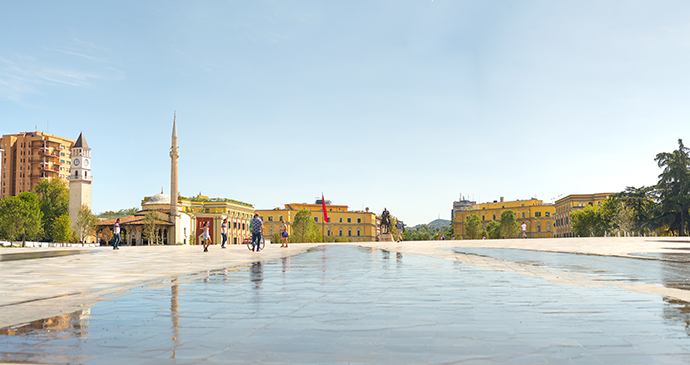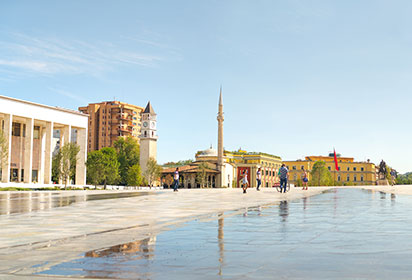Written by Gillian Gloyer
 Skanderbeg Square is at the heart of the capital city, Tirana © Alla Simacheva, Shutterstock
Skanderbeg Square is at the heart of the capital city, Tirana © Alla Simacheva, Shutterstock
Albania’s national hero was born Gjergj (George) Kastrioti, the son of a powerful Albanian chieftain who controlled a large swathe of what is now northern Albania from his citadel at Kruja. When the Ottomans advanced towards Kruja in 1433, Gjergj’s father struck a deal with them to be allowed to continue ruling his lands as a vassal – this was not untypical of the decentralised way in which the Ottoman Empire administered Albania in later years too. As part of the deal, Gjergj was sent to be brought up in the sultan’s court, where he was trained as a soldier and given the name Skënder (Alexander), with the honorific ending ‘beg’ (or ‘bey’).
In 1443, the Ottomans suffered a serious defeat at Niš, in Serbia. Skanderbeg seized the moment and raised his family’s standard – the double-headed eagle on a red background which is the national flag of modern Albania – from the castle at Kruja. The exact circumstances in which he did so are unclear, but the traditional version is that he and his men deserted the Ottoman army at Niš and rode from there to Kruja, where Skanderbeg tricked the Ottoman guards into letting him into the citadel.
Skanderbeg seized the moment and raised his family’s standard – the double-headed eagle on a red background which is the national flag of modern Albania.
He then achieved the feat which has given him his place in history. The Albanian clans, like their Scottish counterparts of the same period, spent most of their time fighting each other, which made them easy prey for better-organised invaders. Skanderbeg managed to gather all the clan chiefs together, in Lezha, on 2 March 1444, and made them undertake to put their differences aside. A solemn undertaking of this sort is known in Albanian as besa, an expression which is still widely used in modern times to mean something like ‘word of honour’. The swearing of the oath at Lezha is called besëlidhja in Albanian, and has given its name to the town’s main square.
The Lezha besa allowed the clans to concentrate on fighting the invaders, and they held them at bay for an astonishing 34 years. Kruja came under siege in 1449–50, and many died before the Ottoman forces withdrew. The sultan, Murad II, died soon after the retreat from Kruja. His successor Mehmed II turned his attention to Constantinople, and it was not until he had conquered that city that he returned to Albania. Meanwhile, Skanderbeg tried to rally support for his beleaguered country from other European nations, but his diplomatic initiatives brought little success. In 1466, the Ottoman army returned to Kruja; Skanderbeg sought military assistance from Naples, which enabled him to break the siege the following year.
Skanderbeg died of malaria in Lezha in 1468, leaving only a son who was too young to take over his father’s command; yet the besa held and the clans stayed united against the Ottomans. Kruja finally fell in 1478. The last citadel to be lost was Rozafa Castle in Shkodra, the following year. Folk legend has it that Skanderbeg’s son led a group of Albanians across the Adriatic to settle in southern Italy. To this day there are villages there in which an archaic form of Albanian is spoken; the dialect, and the people who speak it, are called Arbëresh.
The year after the Ottomans had taken Shkodra, they crossed the Adriatic and captured the castle of Otranto. They were unable to hold it for more than a few months, thanks in part to a revolt in Albania which occupied their troops there, and under the next sultan, Bayezid II, they gave up on their plans to expand their conquests westwards beyond the Balkans. It is often said that had it not been for János Hunyadi, the Turks would have taken Vienna and the political fault-lines of Europe would have been hundreds of miles further north than they are. Less attention has been given to the possibility that without Skanderbeg and the Albanian resistance, much of what is now Italy would have fallen, and the faultlines would have been several hundred miles further west.
The death of Skanderbeg
They brought [Skanderbeg] his son – small and tender, with long golden hair. Skanderbeg took him in his arms and said: ‘Oh, my little flower, who has bloomed amid the surge of battle; oh, flower of my broken heart! When I die, my comrades will continue the war. And if it turns out that you are not big enough to hold and wield a sword, take care that the Turks do not imprison you alive and lock the door. I know the Turks well. They try to distort a man’s spirit, to turn him against himself and his clan, to make him an oppressor of his own land. And then honour is blanketed in disgrace.
And so, if you see that you are in trouble, take your mother and three ships, the best we have, and set off across the sea. Then, when you grow up, come back to your land and carry on my struggle. I say this to you not to save you from death, but to save the clan from defilement; because defilement is worse than death.
When you reach that pebbly beach over there, you will see a shady, mournful cypress. There, to the trunk of that cypress, tie my horse; and above the horse, raise my flag so that it ripples; and under the flag, tie my sword. When the sea breeze blows, my horse will whinny, the flag will flutter and my sword will resound under the shady cypress. The Turks will hear it. They will be afraid of the death which my sword brings, and they will not dare to throw themselves into battle.
From Mitrush Kuteli’s Old Albanian Tales
Interested in our Destination of the Month for March, Albania? Take a look at our newest guide:

